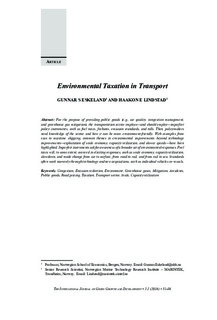| dc.description.abstract | Abstract For the purpose of providing public goods (e.g. air quality, congestion management and greenhouse gas mitigation), the transportation sector employs – and should employ – imperfect policy instruments, such as fuel taxes, feebates, emission standards and tolls. Then, policymakers need knowledge of the sector and how it can be more environmentally friendly. With examples from cars to maritime shipping, we highlight common themes in environmental improvements beyond technology improvements: exploitation of scale economy, capacity utilization and slower speeds. Imperfect instruments ask for awareness of a broader set of environmental responses. Fuel taxes will, to some extent, succeed in eliciting responses such as scale economy, capacity utilization, slowdown, and mode change from air to surface, from road to rail, and from rail to sea. Standards often work narrowly through technology and new acquisitions, such as individual vehicles or vessels. Keywords: Congestion, emission reduction, environment, greenhouse gases, mitigation, accidents, public goods, road pricing, taxation, transport sector, scale, capacity utilization. Acknowledgement: The authors gratefully acknowledge support from the Research Council of Norway, CenSES and HyFiTransport, stays at World Bank and Stanford, as well as remarks from Somik Lall, Larry Goulder and Roar Aadland. Remaining issues rest with the authors. Additional comments were received from participants at the GGKP’s Third Annual Conference on “Fiscal Policies and the Green Economy Transition: Generating Knowledge – Creating Impact”, held in Venice, Italy, 29-30 January 2015. | nb_NO |

